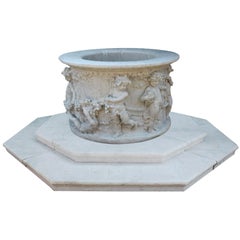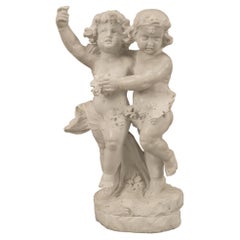New in USA - Fountains
1
to
1
1
1
1
1
1
1
1
Height
to
1
1
1
1
1
Item Ships From: USA
This Week's Listings Only
Italian 19th-20th Century Whimsical White Marble Wishing Wellhead with Children
Located in Los Angeles, CA
A very fine and exceptionally carved Italian 19th-20th century Baroque Revival style whimsical white Carrara marble wishing wellhead, raised on an octagonal two-step marble base. The intricately carved marble relief circular wellhead depicting carved figures of dancing and cheerful children (Putti) among vines, flowers and fruits, dancing and playing musical instruments with a backdrop of castles, landscapes, forests and wreaths, Florence, circa, 1900.
Literature:
A similar wellhead was sold by Jan's & Co. Fine French Antiques, Inc. in 1999, provenance the Atkinson/Kirkeby Estate and it is illustrated in "The Estates of Beverly Hills" by Charles Lockwood and Jeff-Hyland, page 150.
Another similar is currently on display at the gardens of "The Elms" mansion a public museum part of the Newport Mansions by The Preservation Society of Newport County in Newport, Rhode Island.
Yet another similar wellhead carved with frolicking putti with musical instruments and a dentil molded rim is located at Cranbrook House, Bloomfield Hills, Michigan, and is illustrated in B. Israel, Antique Garden Ornament...
Category
Early 1900s Italian Baroque Revival Antique New in USA - Fountains
Materials
Carrara Marble
Related Items
Italian 19th Century White Carrara Marble Statue of Two Children Playing
Located in West Palm Beach, FL
A charming and high quality Italian 19th century white Carrara marble statue of two children playing. The statue is raised by a circular base with a ground like design. Above are Bac...
Category
19th Century Italian Antique New in USA - Fountains
Materials
Carrara Marble
H 24.5 in W 14.5 in D 9.75 in
Italian Sink in White Carrara Marble 20th Century
By Europa Antiques
Located in Madrid, ES
Italian sink in white Carrara marble 20th century
Four sides sanded by hand.
Roughing of the stone, carried out by the stonemason using a tool called a ...
Category
20th Century Italian Modern New in USA - Fountains
Materials
Carrara Marble
Leather Horse, Italy, Late 19th, Early 20th Century
Located in Milano, IT
Papier-mâché horse covered in leather with metal elements.
Category
Late 19th Century Italian Other Antique New in USA - Fountains
Materials
Leather
Antique Italian White Carrara Marble Trougle, 19th Century
By Europa Antiques
Located in Madrid, ES
Antique Italian white Carrara marble trougle, 19th century.
Measures : height 20 cm.
width 34 cms.
length 45 cm.
internal depth of the...
Category
19th Century Italian Baroque Antique New in USA - Fountains
Materials
Carrara Marble
Early 20th Century Italian White Marble Stoup
By Europa Antiques
Located in Madrid, ES
Early 20th Century WHITE MARBLE STOUP
Italy
amazing condition
hand made
HEIGHT 15cm
WIDTH 52cm
DEPTH 50cm.
Category
Early 20th Century Italian Baroque New in USA - Fountains
Materials
Carrara Marble, Marble
Italian Ancient Marble Sculpture Fountain, Late 16th Century
Located in Milano, IT
Sea monster
Carrara marble mouth fountain
Italy, late 16th century
It measures 13.8 x 31.5 x 18.9 in (35 x 80 x 48 cm)
State of conservation: some small evident gaps and widespread signs of wear due to outdoor exposure. The gray marks crossing it do not come from restoration, but are rather the natural veins of the marble.
This work has some morphological characteristics typically associated with the iconography of the sea monster: an elongated muzzle, sharp teeth, protruding eyes, elongated ears, and a coiled serpent's tail.
An in-depth series of studies on artistic depictions of the sea monster attempted to verify how this symbol evolved in antiquity in the European and Mediterranean contexts and how it gradually changed its image and function over time. The iconography itself is mutable and imaginative and its history is rich with cultural and artistic exchange, as well as the overlapping of ideas. This occurred so much that it is difficult to accurately pinpoint the "types" that satisfactorily represent its various developments.
However, we can try to summarize the main figures, starting from the biblical Leviathan and the marine creature that swallowed Jonah (in the Christian version, this figure was to become a whale or a "big fish", the “ketos mega”, translation of the Hebrew “dag gadol”). Other specimens ranged from the dragons mentioned in the Iliad (which were winged and had legs) to "ketos” (also from Greek mythology), the terrifying being from whose Latinized name (“cetus”) derives the word "cetacean". See J. Boardman, “Very Like a Whale” - Classical Sea Monsters, in Monsters and Demons in the Ancient and Medieval Worlds, in Papers presented in Honor of Edith Porada, Mainz am Rhein 1987, pp. 73-84).
In Italy the monster underwent yet further variations: it can be found in Etruscan art on the front of some sarcophagi representing the companion of souls, while among the Romans we find the “Pistrice” (cited by Plinio in Naturalis Historia PLIN., Nat., II 9, 8 and by Virgilio in Eneide: VERG., Aen., III, 427), which appeared in the shape of a stylized hippocampus or a very large monstrous cetacean and evolved into a hideous being with a dragon's head and long webbed fins.
During the Middle Ages, the sea monster was the object of new transformations: at this time, it is often winged, the head is stretched like a crocodile, the front legs are often very sharp fins - sometimes real paws - until the image merges with dragons, the typical figures of medieval visionary spirituality widely found throughout Europe (on this topic and much more, see: Baltrušaitis, J., Il Medioevo fantastico. Antichità ed esotismi nell’arte gotica, Gli Adelphi 1997).
In Italy during the 15th and 16th centuries, the revival of classicism - representative of the humanistic and Renaissance periods - led to a different reading of these "creatures". Indeed, the sea monster was also to find widespread use as an isolated decorative motif, especially in numerous fountains and sculptures where dolphins or sea monsters were used as a characterizing element linked to water (on this theme see: Chet Van Duzer, Sea Monsters on Medieval and Renaissance Maps, London, The British library, 2013).
From the morphological point of view, the "sea monsters" of this period are mostly depicted as hybrid figures, in which the body of a mythological or real being (a hippocampus, a sea snake, a dolphin), is joined to a head with a rather indistinct appearance. It was usually characterized by large upright ears, an elongated snout, sharp teeth and globular, protruding eyes; a complex and indefinite figure, both from the symbolic point of view and from that of its genesis.
The work we are examining is placed as a cross between the medieval sea serpent and the Renaissance dolphin, with stylistic features which recall the snake as often used in heraldry (such as the "snake" depicted in the coat of arms of the Visconti - the lords and then dukes of Milan between 1277 and 1447 - and which, for some, may be derived from the representations of the “Pistrice” that swallowed Jonah).
In the search for sources, Renaissance cartography and in particular woodcuts should not be neglected. See for example the monsters of Olaus Magnus, from the editions of the “Historia de gentibus septentrionalibus” (“History of the peoples of the north”) and the natural histories of Conrad Gesner, Ulisse...
Category
16th Century Italian Renaissance Antique New in USA - Fountains
Materials
Carrara Marble
19th Century French Marble and Bronze Fountain
Located in Essex, MA
19th century French marble and bronze fountain. Seated satyr on marble column with marble shell basin. Later cast stone plinth. Wonderful garden ele...
Category
Late 19th Century French Louis XV Antique New in USA - Fountains
Materials
Marble, Bronze
17th Century, Carrera Marble Lion Fountain Head
Located in Newport Beach, CA
Stunning, solid white, Carrara marble lions head from a fountain in Florence featuring a flowing main and a fabulous patina. Mounted on a custom, iron base. The piece hails from the ...
Category
Early 1600s Italian Antique New in USA - Fountains
Materials
Marble
19th Century Marble Italian Signed Children Sculpture, 1890
Located in Vicoforte, Piedmont
Beautiful Italian sculpture from the late 19th century. Finely sculpted marble work depicting children with crab of excellent quality. Object of beautiful size and proportions signed...
Category
1890s Italian Antique New in USA - Fountains
Materials
Marble
Free Shipping
H 22.84 in W 11.03 in D 9.85 in
Italian 19th Century White Carrara Marble Statue
Located in West Palm Beach, FL
A stunning and extremely high quality Italian 19th century white Carrara marble statue. The wonderfully executed statu...
Category
19th Century Italian Antique New in USA - Fountains
Materials
Carrara Marble
Wooden Carved Black Forest Garden Fountain Water Spout 19th century
Located in Berghuelen, DE
Wooden Carved Black Forest Garden Fountain Water Spout 19th century
A large Black Forest wooden carved water spout featuring "Ruebezahl", which is the mountain spirit of the giant m...
Category
Late 19th Century German Black Forest Antique New in USA - Fountains
Materials
Wood
Italian 19th Century White Carrara Marble Statue
Located in West Palm Beach, FL
A stunning and most charming Italian 19th century white Carrara marble statue. The statue is raised by a wonderfully e...
Category
19th Century Italian Antique New in USA - Fountains
Materials
Marble
Recently Viewed
View AllMore Ways To Browse
French And Hollywood Patio Furniture
Shell Basin
Garden Water Trough
Hollywood Mediterranean
Antique French Wall Fountain
Marble Water Fountain
Cast Stone Fountains
Carved Limestone Water Fountain
Marble Fountain Basin
White Marble Fountain
Fountain Head Bronze
Antique Basin Italian
Wall Mounted Fountain
Tall Fountain
Water Fountain Mid Century
Carved Stone Fountain Spout
Natural Stone Fountain
Fountain With Fish


